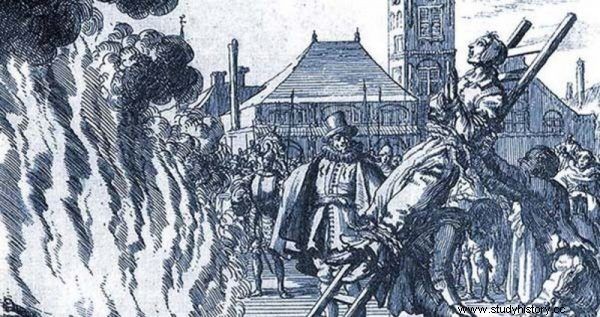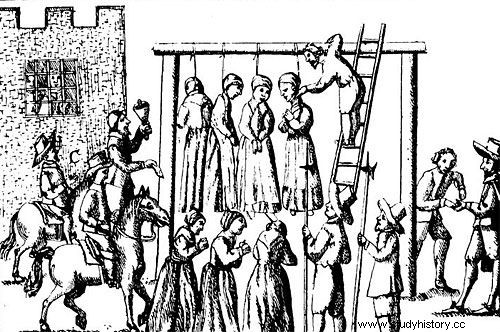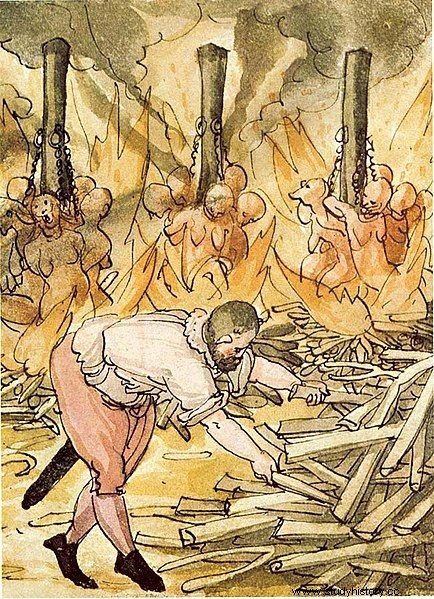The sixteenth and seventeenth centuries in Europe were marked by the witch hunt. Women were accused of organizing Sabbaths, negotiating with the Devil, and engaging in licentious sex with him. From today's perspective, this image may even be funny for us, but a few hundred years ago no one was laughing at all ...
The witch hunt - the Middle Ages and religious fanaticism?
One of the most popular myths is that witch hunts took place mostly in the Middle Ages. However, they were only initiated at the end of this epoch (ca. 1400), and the real apogee was after 1560 and continued until the 18th century. One of the last victims was Anna Göldi, murdered in 1782 in Glarus, Switzerland .
The first known painting of a woman on a broom was created around 1440 and it is on the margin of the manuscript "Le Champion des dames" by Martin Le Franc and was a harbinger of enormous repression and torture. The concept of the coven was summed up by the historian Guy Bechtel with the words: This great ideological poem has had many murders on its account.

The first known image of a woman on a broom is on the margin of the manuscript "Le Champion des dames" by Martin Le Franc
The second important myth is that the pursuit of witches was primarily related to religious fanaticism. Although every sphere of life was related to religion, the activity of the inquisitors themselves was focused mainly on heretics, and the highest percentage of witch sentences was decided by secular courts . Guy Bechtel stated that: [the secular judges showed] greater cruelty and greater fanaticism than Rome.
Demonization of women
Winding up a spiral of hatred and the pursuit of rationalization of what initially seemed unwise led to the appointment of a new scapegoat, which has become women and hunting mainly for them. Although men were also accused of witchcraft, the primary driving force was misogyny. This growing hostility has led to the recognition of violence as a means to protect society from imaginary evil. This situation is best described in the words of Françoise d'Eaubonne: [Human ability] to unleash a slaughter with the wisdom of a madman.
Witches were considered a serious threat to humanity because their psychophysical weakness and insatiable sexual desires would lead them to succumb to the Devil and become puppets in his hands . In witchcraft trials, women made up about 80% of the accused and 85% of the inmates. It is worth knowing that many situations of burning men at the stake resulted from a family or intimate connection with the alleged witch.

Smoking at the stake
The demonization of women and making them scapegoats was neither a coincidence nor an idea of the lowest social classes. These are the best educated people who use the most effective means of communication, incl. popular sermons or newly created print have skillfully manipulated society.
"Hammer of the witches"
"Malleus Maleficarum" or "Hammer for Witches" is a treatise written by Jakob Sprenger, an inquisitor from Basel, in collaboration with Alsatian Heinrich Kramer. This bible of fighting witches was published in 1487 and sold over thirty thousand copies throughout Europe during the time of the greatest hunts. .
Guy Bechtel in his book "La Sorcière et l'Occident" emphasized the importance of the work of "Maleus Maleficarum" at that time:
In this epoch of the fire, judges used this work in all trials. They asked questions taken from "Hammer for Witches" and listened to its answers .
The publication of Hammer for Witches sparked an avalanche of more works on the same subject and an increase in the number of demonology experts.

Execution of women suspected of witchcraft
Hunt for women
The area around the German city of Trier is one of the most important seeds of the witch hunt. It was there, from 1587 to 1593, 368 women were burned at the stake in more than twenty villages, and in two of these villages the female population decreased to a maximum of one woman . These types and many other kinds of chilling stories can be served in a dime a dozen.
An interesting fact is also that many believers believed that witchcraft was hereditary, so whole generations of women were sentenced to death with great zeal from grandmother, through mother and aunt, to daughter. The sentencing authorities were staffed by men, ranging from investigators, priests to judges and executioners.
It is worth considering why the men related to witches did not defend the accused women. This was mainly due to the fear that they themselves would be brought to trial and then to the stake, so some, fearing reprisals, even joined the accusers. Some calculating men have used the ubiquitous witch hunt and accused innocent women of using dark magic to remove an unwanted wife, mistress, or victim of sexual harassment from their lives.

Mass Execution at the Stack
How easy was it to hit the stack?
Any behavior deviating from the accepted norm attracted the attention of the witch hunter. Among them were so many factors that we consider normal today: too provocative attire, overexposed sexuality, strong character, raising one's voice or attending mass too rarely or frequently . The very body of the woman was also sufficient reason to link her to the Devil. The detained women were undressed, hair shaved on their heads and the search for external or internal changes was started. All it took was an unnatural spot or scar on her skin to find a woman guilty.
One of the most famous and absurd ways of testing women to see if they were rightly accused was the water test. When the woman began to drown, she was innocent, but if she remained afloat, her suppositions were confirmed and she had to be burned at the stake .
Misogyny, demonization of women and making them scapegoats have been the cause of suffering and death for many women. The period of the witch-hunts has shaken the self-confidence of the female part of society for many generations ahead, and the treatise "Hammer of Witches" is now placed on one shelf of Adolf Hitler's "Mein Kampf".
Bibliography:
1. M. Chollet, Witches. The invincible power of women, Karakter 2019.
2. G. Bechtel, La Sorcière et l'Occident. La destruction de la sorcellerie en Europe, des origines aux grands bûchers , Paris 1997.
3. F. d'Eaubonne, Le Sexocide des sorcières , Paris 1999.
4. A. L. Barstow, Witchcraze, A New History of the European Witch Hunts , New York 1994.
5. S. Federici, Caliban et la sorcière. Femmes, corps et accumulation primitive , Genève – Marseille 2014.
